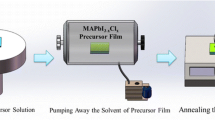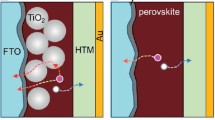Abstract
The quality of the perovskite light absorption layer plays a dynamic role in the photovoltaic properties of solar cells. The existing methods to prepare methylammonium lead iodide (MAPbI3) films render substantial structural defect density, particularly at the grain boundaries and film surface, constituting a challenge that hinders the further optoelectronic enhancement of perovskite solar cells. Herein, a unique approach was introduced: using a simple ethylammonium chloride (EACl) additive in perovskite precursor mixture to produce high-quality MAPbI3 thin films. The results indicated that EACl could encourage perovskite crystal growth without experiencing the intermediate phase formation and would evaporate from the perovskite after annealing. Additionally, a gradient perovskite structure was achieved using this technique, which impressively enhanced the performance of the perovskite films. A high power conversion efficiency (PCE) of 20.03% was achieved under the optimal amount of EACl, and the resultant efficient device could retain over 89% of the original PCE after aging for 1000 h at room temperature. This novel technique leads to a facile fabrication of high-quality and less-defect perovskite thin films for competent and stable devices.
摘要
钙钛矿光吸收层的质量对太阳电池的光伏性能有重要的影 响. 目前, 制备甲基铵基碘化铅钙钛矿(MAPbI3)的方法会产生大量缺陷态, 特别是在晶界和薄膜表面, 这些问题阻碍了钙钛矿太阳电池性能进一步提升. 本文介绍了一种采用乙胺盐酸盐(EACl)添加剂制备高质量MAPbI3的特殊方法, 发现EACl可以使得钙钛矿晶体不通过中间相形成, 并在退火后从钙钛矿中蒸发. 此外, 该方法还获得了梯度钙钛矿结构, 显著提高了钙钛矿薄膜的性能. 在最佳EACl用量下, 器件的光电转换效率(PCE)达到20.03%. 器件在室温老化 1000 h后仍能保持原有PCE的89%. 这一新方法可以简易制备高质量、 缺陷少的钙钛矿薄膜, 以生产更加稳定的器件.
Similar content being viewed by others
References
Kojima A, Teshima K, Shirai Y, et al. Organometal halide perovskites as visible-light sensitizers for photovoltaic cells. J Am Chem Soc, 2009, 131: 6050–6051
Jung HS, Park NG. Perovskite solar cells: from materials to devices. Small, 2015, 11: 10–25
Jeon NJ, Noh JH, Yang WS, et al. Compositional engineering of perovskite materials for high-performance solar cells. Nature, 2015, 517: 476–480
Kim HS, Mora-Sero I, Gonzalez-Pedro V, et al. Mechanism of carrier accumulation in perovskite thin-absorber solar cells. Nat Commun, 2013, 4: 2242
Ball JM, Lee MM, Hey A, et al. Low-temperature processed mesosuperstructured to thin-film perovskite solar cells. Energy Environ Sci, 2013, 6: 1739–1743
Liu C, Yang Y, Ding Y, et al. High-efficiency and UV-stable planar perovskite solar cells using a low-temperature, solution-processed electron-transport layer. ChemSusChem, 2018, 11: 1232–1237
Jiang Q, Zhao Y, Zhang X, et al. Surface passivation of perovskite film for efficient solar cells. Nat Photonics, 2019, 13: 460–466
https://www.nrel.gov/pv/assets/images/efficiency-chart.png (accessed: 2019)
Guo L, Fei C, Zhang R, et al. Impact of sol aging on TiO2 compact layer and photovoltaic performance of perovskite solar cell. Sci China Mater, 2016, 59: 710–718
Arain Z, Liu C, Ren Y, et al. Low-temperature annealed perovskite films: A trade-off between fast and retarded crystallization via solvent engineering. ACS Appl Mater Interfaces, 2019, 11: 16704–16712
Yang Y, Peng H, Liu C, et al. Bi-functional additive engineering for high-performance perovskite solar cells with reduced trap density. J Mater Chem A, 2019, 7: 6450–6458
Liang PW, Liao CY, Chueh CC, et al. Additive enhanced crystallization of solution-processed perovskite for highly efficient planar-heterojunction solar cells. Adv Mater, 2014, 26: 3748–3754
Chen J, Xu J, **ao L, et al. Mixed-organic-cation (FA)x(MA)1−xPbI3 planar perovskite solar cells with 16.48% efficiency via a low-pressure vapor-assisted solution process. ACS Appl Mater Interfaces, 2017, 9: 2449–2458
Wu YZ, Ding Y, Hayat T, et al. Enlarged working potential window for MnO2 supercapacitors with neutral aqueous electrolytes. Appl Surf Sci, 2018, 459: 430–437
Dong Q, Fang Y, Shao Y, et al. Electron-hole diffusion lengths >175 µm in solution-grown CH3NH3PbI3 single crystals. Science, 2015, 347: 967–970
Liu D, Gangishetty MK, Kelly TL. Effect of CH3NH3PbI3 thickness on device efficiency in planar heterojunction perovskite solar cells. J Mater Chem A, 2014, 2: 19873–19881
Etgar L, Gao P, Xue Z, et al. Mesoscopic CH3NH3PbI3/TiO2 heterojunction solar cells. J Am Chem Soc, 2012, 134: 17396–17399
Zhang F, Cong J, Li Y, et al. A facile route to grain morphology controllable perovskite thin films towards highly efficient perovskite solar cells. Nano Energy, 2018, 53: 405–414
Bi D, Yi C, Luo J, et al. Polymer-templated nucleation and crystal growth of perovskite films for solar cells with efficiency greater than 21%. Nat Energy, 2016, 1: 16142
Zheng H, Dai S, Zhou K, et al. New-type highly stable 2D/3D perovskite materials: The effect of introducing ammonium cation on performance of perovskite solar cells. Sci China Mater, 2019, 62: 508–518
Ran C, Xu J, Gao W, et al. Defects in metal triiodide perovskite materials towards high-performance solar cells: origin, impact, characterization, and engineering. Chem Soc Rev, 2018, 47: 4581–4610
Jeon NJ, Noh JH, Kim YC, et al. Solvent engineering for highperformance inorganic-organic hybrid perovskite solar cells. Nat Mater, 2014, 13: 897–903
Ding X, Ren Y, Wu Y, et al. Sequential deposition method fabricating carbonbased fully-inorganic perovskite solar cells. Sci China Mater, 2018, 61: 73–79
Wu Y, **e F, Chen H, et al. Thermally stable MAPbI3 perovskite solar cells with efficiency of 19.19% and area over 1 cm2 achieved by additive engineering. Adv Mater, 2017, 29: 1701073
Ma S, Cai M, Cheng T, et al. Two-dimensional organic-inorganic hybrid perovskite: From material properties to device applications. Sci China Mater, 2018, 61: 1257–1277
Wu CG, Chiang CH, Han HC. Manipulating the horizontal morphology and vertical distribution of the active layer in BHJ-PSC with a multi-functional solid organic additive. J Mater Chem A, 2014, 2: 5295–5303
Li X, Bi D, Yi C, et al. A vacuum flash-assisted solution process for high-efficiency large-area perovskite solar cells. Science, 2016, 353: 58–62
Arain Z, Liu C, Yang Y, et al. Elucidating the dynamics of solvent engineering for perovskite solar cells. Sci China Mater, 2019, 62: 161–172
Ahn N, Son DY, Jang IH, et al. Highly reproducible perovskite solar cells with average efficiency of 18.3% and best efficiency of 19.7% fabricated via Lewis base adduct of lead(II) iodide. J Am Chem Soc, 2015, 137: 8696–8699
Xu J, Buin A, Ip AH, et al. Perovskite-fullerene hybrid materials suppress hysteresis in planar diodes. Nat Commun, 2015, 6: 7081
Lee JW, Kim HS, Park NG. Lewis acid-base adduct approach for high efficiency perovskite solar cells. Acc Chem Res, 2016, 49: 311–319
Wu CG, Chiang CH, Tseng ZL, et al. High efficiency stable inverted perovskite solar cells without current hysteresis. Energy Environ Sci, 2015, 8: 2725–2733
Yin WJ, Chen H, Shi T, et al. Origin of high electronic quality in structurally disordered CH3NH3PbI3 and the passivation effect of Cl and O at grain boundaries. Adv Electron Mater, 2015, 1: 1500044
Mateen M, Arain Z, Yang Y, et al. MACl-induced intermediate engineering for high-performance mixed-cation perovskite solar cells. ACS Appl Mater Interfaces, 2020, 12: 10535–10543
Dong Q, Yuan Y, Shao Y, et al. Abnormal crystal growth in CH3 NH3PbI3−xClx using a multi-cycle solution coating process. Energy Environ Sci, 2015, 8: 2464–2470
**e F, Chen CC, Wu Y, et al. Vertical recrystallization for highly efficient and stable formamidinium-based inverted-structure perovskite solar cells. Energy Environ Sci, 2017, 10: 1942–1949
Mateen M, Arain Z, Liu C, et al. High-quality (FA)x(MA)1−xPbI3 for efficient perovskite solar cells via a facile cation-intermixing technique. ACS Sustain Chem Eng, 2019, 7: 11760–11768
Ren Y, Duan B, Xu Y, et al. New insight into solvent engineering technology from evolution of intermediates via one-step spin-coating approach. Sci China Mater, 2017, 60: 392–398
Mateen M, Arain Z, Liu X, et al. High-performance mixed-cation mixed-halide perovskite solar cells enabled by a facile intermediate engineering technique. J Power Sources, 2019, 448: 227386
Zhao W, Yang D, Liu SF. Organic-inorganic hybrid perovskite with controlled dopant modification and application in photovoltaic device. Small, 2017, 13: 1604153
Ren Y, Hao Y, Zhang N, et al. Exploration of polymer-assisted crystallization kinetics in CsPbBr3 all-inorganic solar cell. Chem Eng J, 2019, 392: 123805
Handa T, Tex DM, Shimazaki A, et al. Charge injection mechanism at heterointerfaces in CH3NH3PbI3 perovskite solar cells revealed by simultaneous time-resolved photoluminescence and photocurrent measurements. J Phys Chem Lett, 2017, 8: 954–960
Shi P, Ding Y, Liu C, et al. Advanced partial nucleation for singlephase FA0.92MA0.08PbI3-based high-efficiency perovskite solar cells. Sci China Mater, 2019, 62: 1846–1856
Zhou Z, Xu J, **ao L, et al. Efficient planar perovskite solar cells prepared via a low-pressure vapor-assisted solution process with fullerene/TiO2 as an electron collection bilayer. RSC Adv, 2016, 6: 78585–78594
Wu YH, Ding Y, Liu XY, et al. Ambient stable FAPbI3-based perovskite solar cells with a 2D-EDAPbI4 thin cap** layer. Sci China Mater, 2019, 63: 47–54
Sajid S, Elseman AM, Wei D, et al. NiO@carbon spheres: A promising composite electrode for scalable fabrication of planar perovskite solar cells at low cost. Nano Energy, 2019, 55: 470–476
Ma S, Qiao W, Cheng T, et al. Optical-electrical-chemical engineering of PEDOT:PSS by incorporation of hydrophobic nafion for efficient and stable perovskite solar cells. ACS Appl Mater Interfaces, 2018, 10: 3902–3911
Zhang X, Zhou Z’, Ma S, et al. Fused tetraphenylethylene-triphenylamine as an efficient hole transporting material in perovskite solar cells. Chem Commun, 2020, 56: 3159–3162
Wang Z, Wang L. Photoelectrode for water splitting: Materials, fabrication and characterization. Sci China Mater, 2018, 61: 806–821
Sun M, Zhang F, Liu H, et al. Tuning the crystal growth of perovskite thin-films by adding the 2-pyridylthiourea additive for highly efficient and stable solar cells prepared in ambient air. J Mater Chem A, 2017, 5: 13448–13456
Acknowledgements
This work was supported by the National Key R&D Program of China (2019YFB1503202), the 111 Project (B16016), the National Natural Science Foundation of China (51702096, U1705256 and 61904053), and the Fundamental Research Funds for the Central Universities (2019MS026, 2019MS027 and 2020MS080).
Author information
Authors and Affiliations
Contributions
Author contributions Mateen M performed the main experiments and wrote the paper; Ren Y, Zhang X, Iqbal A, Liu C, Chen Q, Ma S, and Cai M helped to fabricate the devices, analyze the data; Arain Z, Liu X and Ding Y helped to conceive the framework of this paper and review the manuscript; Dai S supervised the project. All authors contributed to the general discussion about the work.
Corresponding authors
Ethics declarations
Conflict of interest The authors declare that they have no conflict of interest.
Additional information
Muhammad Mateen obtained his Master’s degree from the Shah Abdul Latif University. Currently, he is a PhD candidate in North China Electric Power University (NCEPU) under the supervision of Prof. Songyuan Dai. His research interests mainly focus on the perovskite solar cells.
Xuepeng Liu received his PhD from the University of Science and Technology of China (USTC) in 2018. He is a lecture in NCEPU now. His research interests focus on perovskite solar cells.
Yong Ding received his PhD degree from Hefei Institutes of Physical Science, Chinese Academy of Sciences (CAS) in 2016. After graduation, he became a lecturer in NCEPU. His research interests focus on the 2D perovskite-based photoelectric devices, including perovskite solar cells and light-emitting diodes.
Songyuan Dai is a professor in NCEPU. He obtained his BSc degree in physics from Anhui Normal University in 1987, and MSc and PhD degrees in plasma physics from the Institute of Plasma Physics, Chinese Academy of Sciences in 1991 and 2001, respectively. His research interests mainly focus on the next-generation solar cells including dye-sensitized solar cells, quantum dot solar cells and perovskite solar cells.
Electronic supplementary material
Rights and permissions
About this article
Cite this article
Mateen, M., Arain, Z., Liu, X. et al. Boosting optoelectronic performance of MAPbI3 perovskite solar cells via ethylammonium chloride additive engineering. Sci. China Mater. 63, 2477–2486 (2020). https://doi.org/10.1007/s40843-020-1383-3
Received:
Accepted:
Published:
Issue Date:
DOI: https://doi.org/10.1007/s40843-020-1383-3




